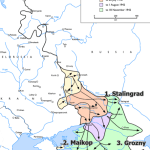The Third Reich 1942 - 1945 AAR Turn 002.
Operation Fridericus and Case Blue - The Historical Narrative.
Operation Fridericus was essentially the first phase of Case Blue, culminating in the Battle of Voronezh -a mere 280 miles south of Moscow. Axis forces included Fourth Panzer Armee under General Hermann Hoth versus the Soviet 40th Army of the Southwestern Front under the command of General Nikolai Fyodorovich Vatutin. Following the capture of the city, Fourth Panzer would then pivot south to support the German Sixth Armee under General Paulus, destination Stalingrad.
Case Blue itself had two primary sets of objectives which led to Army Group South being split into two Operational Groups (A and B). The ultimate strategic objective of this operation was the capture of the Soviet oil fields of the Caucasus, namely Maikop, Grozny and Baku. We’ll get into specifics of this later and separately, but it is appropriate here to put these objectives into context of the whole War in the East.
Axis forces held a front line stretching from Leningrad to Rostov-on-Don, with assorted dips and bulges. As the crow flies, this front was 2,300 kilometers (1,425 miles) long. The strategic objectives of Case Blue would require Axis forces to advance another 1,125 kilometers or about 700 miles - tacking on a notional 50% to their front lines. The following shows some additional relational data.
* Rostov to Maikop - 300 km (185 miles)
* Maikop to Grozny - 500 km (310 miles)
* Grozny to Baku - 474 km (295 miles)
* Sochi to Baku - 900 km (560 miles)
Baku would not only require advancing 1,125 kilometers, it would also require doing so, nominally, on a 900 kilometer front - that being the distance between the Black Sea and the Caspian Sea.
Sounds like a nightmare. Sounds like an impossibility. There is the simple historical fact that the Axis forces failed to achieve their objectives. That also tends to leave the impression that it actually was impossible - with the “conventional wisdom” that the whole notion was some hair-brained exercise in futility.
I would assert otherwise for a long list of reasons which we are about to explore in some depth. The plan was valid, its execution was flawed.
And that brings us to the Second Objective… Stalingrad. It sort of speaks for itself.
There is so much to cover with Case Blue that it will need to be broken down into parts. These parts are not in any way separate from each other, they are all connected - but it is easier to focus upon and write about one specific issue at a time. And we’ll get to all of it in due course… let the suspense build a bit, for now - back to the game!
Case Blue - Planning Take Two without Further Adieu
Case Blue will be conducted in two phases. The first phase requires reaching designated stop lines along the Don River - from Voronezh to the approach to Stalingrad. The Don River serves as a wonderful defensive barrier for both sides. This phase also includes taking Rostov on Don and establishing a bridgehead in the Kuban region to its immediate south. The Luftwaffe’s primary task during this stage, is to provide air cover, combat support, and conduct bridge bombing on the rail lines leading out of the Astrakahn to the south of Stalingrad.
Depleted and worn out units will then be mustered for redeployment to quieter fronts and fresh troops railed back to replace them.
The second phase will involve breaking out from the Kuban Region toward Maikop. Further details of this phase of the operation will be postponed for the sake of security as my opponent will likely be reading these reports, too. Mike has a fair idea of what I intend to do as this is our second attempt at completing the play test. Previously, we reached Turn 15 when we had to terminate the test owing to an incorrectly defined event.
A large portion of the Romanian 3rd and 4th Armies, all but the Alpini Mountain Corps of the Italian 8th Army, plus the Hungarian 2nd Army will comprise a large portion of the defenses along the Don River, as was historical. Their main weakness, aside from leadership, training and supply was their lack of anti-tank weapons capable of dealing with T-34 tanks. Consequently, each of the Hungarian, Romanian and Italian divisions will be paired with a German Infantry Regiment. Other portions of the defensive line will be garrisoned solely by a German infantry brigade (half a division), with road and light river crossings defended by a full German infantry division.
Technically a “regiment” in TOAW under the division-level design amounts to a brigade-sized kampfgruppe — 1 regiment of infantry (2 or 3 battalions each), 1 anti-tank company, 1 engineer company, plus an artillery battalion (up to 12x 105mm howitzers and 4x 150mm howitzers) - under ideal conditions.
Historically, the middle of May, 1942, witnessed the Second Battle of Kharkov - and in this scenario, the Allied Player received 25 permanent victory points if Kharkov can be taken and held if even for just one turn - prior to Turn 6. That amounts to a “simple” two hex advance from the Soviet starting positions. Mike has opted not only to forego the Kharkov offensive, but to withdraw… apparently behind the Don River. And we’ll pause here before jumping into the action and results of the opening offensive which starts taking shape in Turn 003.
Below are snapshots and orders for Army Group Center and the northern shoulder of Army Group South.



